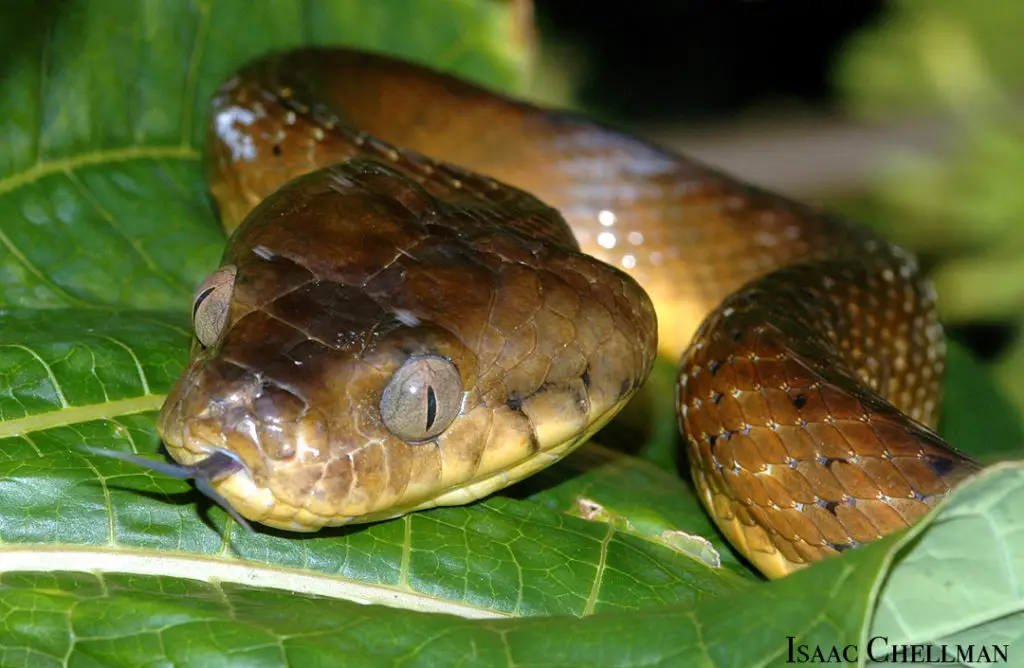
Accidentally introduced to Guam
The brown treesnake was accidentally introduced most likely by the US military to Guam in the late 1940s or early 1950s. The brown treesnake (Boiga irregularis) is a native of Australia, Papua New Guinea, and the Solomon Islands. Based on its coloration and scale patterns, the snakes on Guam are most similar to those of the Admiralty Island group of northern Papua New Guinea. This area had large military bases in World War II and is the most probable region from which the snakes on Guam were inadvertently carried as accidental stowaways in military cargo.
The brown treesnake is a dangerous threat to the economy and ecology of Guam and is the subject of a cooperative program to control snake populations on Guam and prevent its spread throughout the Pacific Rim.
Biology
Brown treesnakes are about 15 inches at hatching and may reach 10 feet in length as adults. Most brown treesnakes are 3 to 4 feet long. This snake is a rear-fanged semiconstrictor and is mildly poisonous. Both constriction and venom are used to help immobilize prey.
The snake’s venom trickles along grooves in the rear fangs into a bite victim. To penetrate skin, a brown treesnake must chew because of the relatively small size and position of the fangs.
The brown treesnake will readily strike when aggravated, but it does not present a danger to adults. A bite from this snake will not penetrate most clothing. However, babies less than six-months-old may be at risk from both brown treesnake bites and constriction. A young victim of a brown treesnake bite should receive immediate medical attention.
The snake is active at night and inhabits trees, shrubs, and forests. Although snakes are usually found in vegetation, they can be encountered almost anywhere. The brown treesnake spends most days coiled in a cool and dark location, such as a treetop or a rotted log. They are adept climbers and can crawl through very small openings.
The brown treesnake is extremely abundant on Guam, with localized estimates sometimes reaching 29 or more snakes per acre of jungle. These population density estimates are among the highest snake densities ever recorded. The only other snake on Guam, the introduced blind snake (Ramphotyphlops braminus), resembles a worm in size and shape and is harmless.
The brown treesnake has caused extensive economic and ecological damage to Guam. It is responsible for numerous power outages across the island each year. This species is an opportunistic feeder and has eradicated most of Guam’s native forest birds.
As bird populations have declined, the snake has turned its focus to Guam’s lizards and rats, mice, domestic birds, and bird eggs. In the snake’s native range, its populations are kept in check through natural processes such as disease, competition for food, and predation. Although these processes likely occur on Guam, they are not adequate enough to control the brown treesnake population.
Conflicts with people
Even though the snake is abundant on Guam, most people rarely encounter a live brown treesnake. These pests do not hang from trees in giant bunches, nor do they actively search out people to bite. In fact, many residents have lived on Guam for years without ever seeing a single snake.
The brown treesnake may be attracted to residential areas by an abundance of rodents, lizards, poultry, or debris that serves as habitat for snake prey. The snake may occasionally enter buildings while searching for food.
Simple precautions, such as keeping doors and screens secured, screening air ducts and pipes that open outdoors, keeping garbage and pet food in secured containers, and removing surrounding vegetation may make a building less attractive to brown treesnakes.
Preventing its spread
Without control, the problems caused by the brown treesnake could spread. The snake has been sighted on many other Pacific islands. It is believed to have arrived through cargo transported by ships or planes originating in Guam. Although no established snake populations are suspected at these locations, the possibility of an incipient population on Saipan exists. These sightings clearly demonstrate the possibility of snakes being transported to vulnerable locations.
The federal government’s Wildlife Services program, administered by the US Department of Agriculture’s Animal and Plant Health Inspection Service (APHIS), coordinates operational efforts on Guam aimed at keeping the snake from reaching other destinations. Wildlife Services personnel use snake trapping in high-risk areas, trained snake-detector dogs in cargo, nighttime spotlight searches, and public education as tools to achieve this goal.
Provided by Guam Wildlife Services office, US Department of Agriculture’s Animal and Plant Health Inspection Service
For further reading
Engeman, Richard M., N. Paige Groninger, and Daniel S. Vice. “A General Model for Predicting Brown Tree Snake Capture Rates.” Environmetrics 14, no. 3 (2003): 295-305.
US Department of Agriculture Animal and Plant Health Inspection Service. “Brown Tree Snake.” Wildlife Damage. Last modified 30 October 2020.
